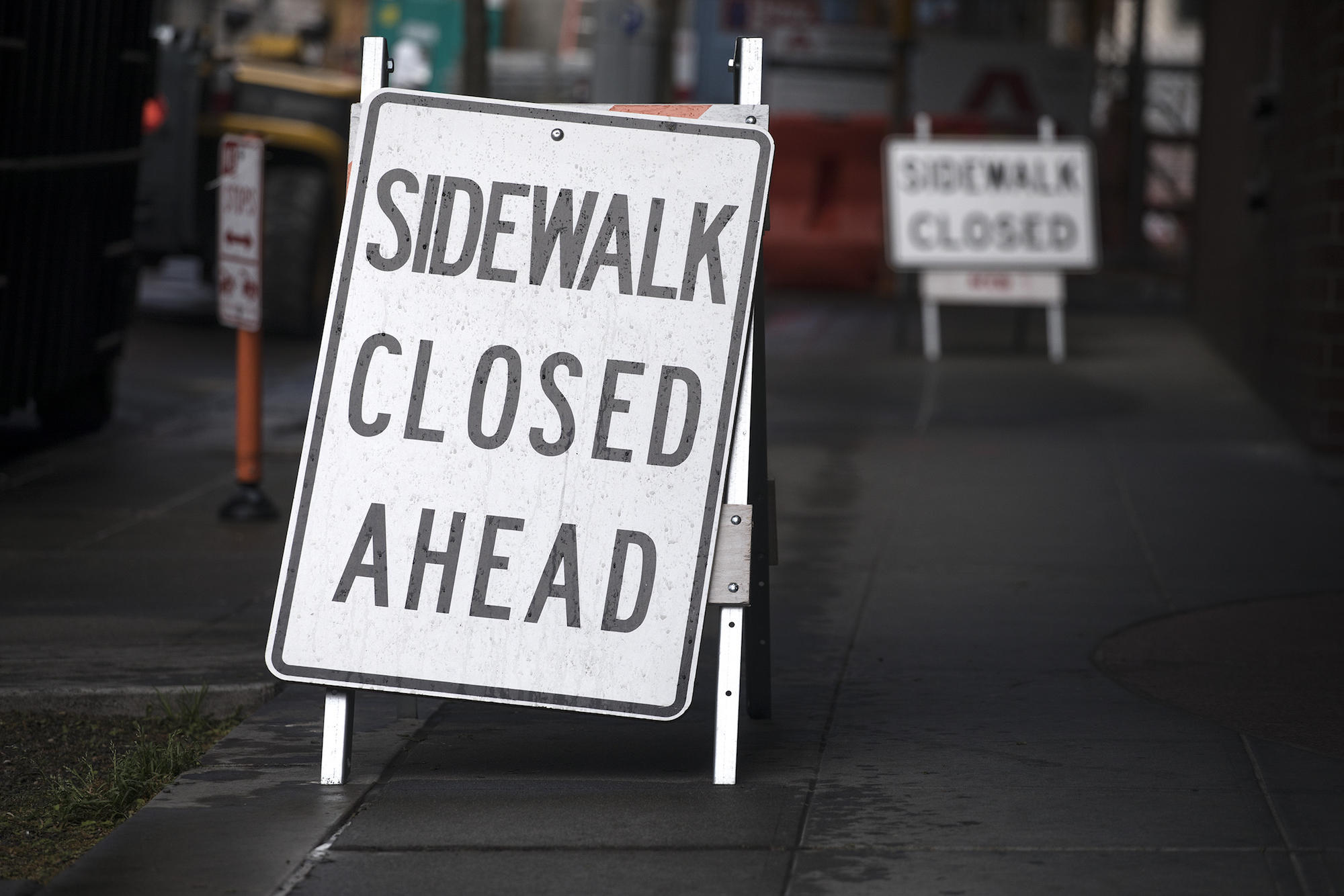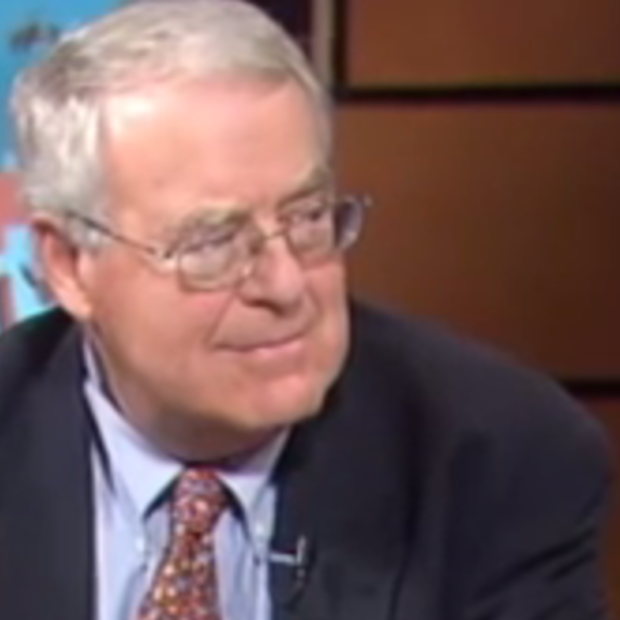Second of two articles on pedestrian safety and sidewalk conditions. Read part 1 here.
Pedestrian safety in Seattle is going in the wrong direction. By the most important measure — fatalities— Seattle had a terrible year in 2017: Eleven people died of injuries suffered as pedestrians. That’s more than half of Seattle’s 2017 total traffic fatalities. It’s double the total of five pedestrian fatalities a year earlier.
There were also an additional 56 serious pedestrian injuries in 2017.
The numbers point to a pedestrian safety crisis that the council and the transportation bureaucracy are not paying enough attention to solving.
And this is a particularly bad time to neglect sidewalks and pedestrian safety. As Seattle grows, risk increases from the sheer numbers of additional people walking in Seattle. They are especially at risk when trying to navigate often unpainted crosswalks and dealing with increasing traffic and drivers impatient with worsening congestion.
There are a lot of people walking, more than politicians and the city seem to see. A recent headline story noted that the share of people who commute to Seattle’s core area jobs by walking surged to 8 percent last year, up from 6 percent in 2010.
But that is a big understatement. Dig into the survey details to find that the share of Seattle’s own residents who actually walk to jobs located downtown is 13 percent.
Even that is an understatement. Virtually everyone who uses the bus or light rail to get to work also is a pedestrian, completing their transit trip on foot. But bus or light-rail commuters are classified only as transit riders, not pedestrians, in the survey.
Seattle’s pedestrian flood tide isn’t just downtown, however; it is even more remarkable in the neighborhoods. The increase is not just about walking to work. In 2016, when the Seattle Department of Transportation (SDOT) caught up with people in the Capitol Hill/15th Avenue East business district, a survey showed 57 percent had walked to the neighborhood. Last year in the University District, 38 percent told SDOT they got there on foot. In Ballard, 31 percent had walked to their destination. It was 41 percent in Uptown/Lower Queen Anne.
Nowhere did bus rider numbers top walking numbers in these neighborhood surveys. Neither did biking, which came in anywhere from a low of 2 percent in Uptown/Lower Queen Anne to a high of 6 percent in Ballard.
Every walking trip in Seattle is the zero-carbon, exercise-friendly, neighborhood-congenial transportation choice. But even with the surge in walking’s popularity, Seattle’s big growth has also brought ever more cars and ever more traffic. Understandable then, but very disheartening, that SDOT’s own research reveals our collective belief that walking is becoming less safe. Interview surveys taken for SDOT show that both downtown and in the neighborhoods, more than half of respondents agreed with the statement, “there are intersections where I do not feel safe crossing,” a higher response in 2014 than in 2008.
Perception of risk is backed with solid data. Vision Zero, the city’s traffic safety improvement campaign, seeks a positive trend of year-after-year declines in the unfolding five-year rolling average of traffic fatalities and serious injuries. For vehicle occupants and bicyclists in Seattle, the trend happily is moving in the right direction. But not for pedestrians. For pedestrian fatalities and serious injuries, every year since 2011 each updating of the five-year rolling average has gone up, not down.
Backward, year after year, on pedestrian safety.
Those bad news statistics only tally the problem of cars colliding with pedestrians. What about dangers on the sidewalks themselves?
Lots of people every day manage to pick their way along Seattle’s often crumbling and obstacle strewn sidewalks. Not everyone is lucky. Misfortune from a fall can range from a skinned knee, to bruises, sprains and broken bones and disabling injuries. For all the energy that the city expends to collect traffic statistics, it has never developed a program to learn about, report on or respond to the scale or severity of how residents or visitors are injured from their encounters with sidewalk defects.
People do, of course, sometimes file claims against the city. Even that data is so squirrelly that the city backed away from a recent preliminary suggestion, in response to my inquiries, that over the last five years claims average about 60 a year. About half apparently result in payouts from the city tending to run on average a total of $1 million to $2 million per year. That would be in the same range as one accurately known number: SDOT’s grossly insufficient total annual spending, generally only about $1.5 million to $2 million in recent years, for sidewalk repairs needed to counter the injury risk.
Looking more closely at sidewalk conditions risk, cost and protecting against injuries, the picture gets even worse. A little appreciated fact is that the city has taken the position that only major sidewalks on the main streets are generally the city’s repair and maintenance responsibility. For the rest, the city has long pronounced that it is the abutting property owners who are legally on the hook for the conditions and maintenance of their sidewalks. Recently chinks may be appearing in SDOT’s not-our-problem approach. Some lawyers maintain, and SDOT seems to be paying attention, that a Tacoma sidewalk defect injury case decided by the state Supreme Court in 1994 might lead to putting liability back on the city.
Sidewalk injuries can be very serious. Bad news of course for the victims. Painful, too for those who might be sued. A recent $4.85 million city settlement in San Diego to a badly injured cyclist who went over the handlebars after hitting a sidewalk tree root should be a cautionary tale given Seattle’s free-for-all sidewalk bike riding as well as the popularity of walking. In Seattle, the defendant, of course, might have been not only the city but an adjoining property owner.
To understand how bad conditions are on our sidewalks, you can — besides walking around the block — look at SDOT’s own assessment of the city’s 2,300 miles of sidewalks (valued at over $5 billion, if they had to be replaced).
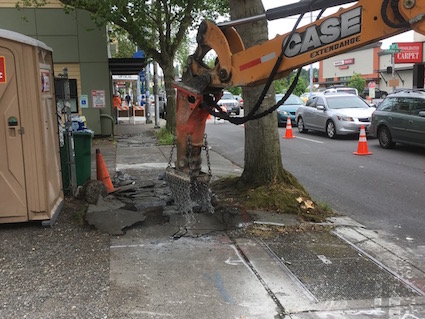
The consequences of inadequate maintenance budgets are clear. In 2017 SDOT sent inspection teams on foot to check every sidewalk in every neighborhood, the first thorough survey ever made. Nearly half the sidewalks in Seattle fell into the condition categories of very poor, poor and only fair. The new survey located 38,000 crumbling sidewalk surfaces, 20,000 way-blocking obstructions including trees and utility poles, and 93,000 half-inch or greater tripping hazards(euphemistically called “height differences”). Some of the most problematic are caused by tree roots that have lifted the sidewalks, often very expensive to fix especially given the competing priority understandably given to keeping, not ripping out, Seattle’s trees.
To put the survey in context, dividing the total number of observed sidewalk defects by the total number of blocks of sidewalk in Seattle, yields the startling overall average result of 4.5 defects per block of sidewalk. SDOT initially has estimated that somewhere between $500 million and $1.3 billion would be the cost of putting things right.
That’s before confronting the related pedestrian — and civil rights — problem of curb ramps. Their terrible condition in Seattle, and their widespread non-existence, is a huge shortfall from requirements of the Americans with Disabilities Act. Faced with a lawsuit from plaintiffs represented by Disability Rights Washington, the city last year acknowledged its liability for violations of the law and agreed to a consent decree requiring installations or fixes of 1,250 ramps a year every year through 2034, more ramps every year than the total number of ramps in nine years SDOT built under the previous transportation levy. That’s a required new total of 22,500 ramps, almost as large a number as the 27,000 existing ramps identified last year. No firm estimate of the consent decree’s ultimate cost has been offered, but the Seattle Times report on the settlement suggested it could be about $300 million. The city dug this hole for itself by slow-walking curb projects for years.
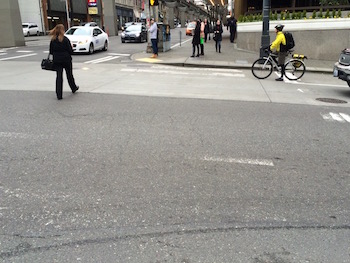
While the settlement forces more curb construction, what is SDOT doing to fix its thousands upon thousands of poor condition sidewalks? In the nine years of funding under the Bridging the Gap levy (2006-2015), SDOT on average repaired or replaced about 25 blocks of sidewalk, each year, far less than one-tenth of 1 percent of the city’s sidewalk inventory. In 2016, SDOT repaired seven blocks of sidewalk; in 2017, five. That’s not what’s needed. It's not even close to being on track toward the miserly proposal of repairing 225 blocks of sidewalk in nine years through 2024 that voters were told to expect from the big Move Seattle levy they approved in 2015.
Seattle has lots of company around the country in facing big sidewalk repair funding gaps with little room in transportation budgets for sidewalks. There are other cities that also try to push repair and maintenance costs on to homeowners. It’s the level of indifference to getting things fixed that seems to be the Seattle special way.
Other cities, moreover, have come up with programs like sharing the costs of repairs with property owners, as in Chicago and Boulder. Or direct financial assistance, as in Denver. Or helping neighbors get together to receive competitive repair bids from city-approved contractors, something San Francisco does. Portland publishes a do-it-yourself manual. One national study concluded that unlike Seattle, in more than half of cities across 40 states, cities carry or share sidewalk repair costs. In Los Angeles, an Americans with Disabilities Act lawsuit settlement has gone beyond curb ramps to require its broken and cracked sidewalks themselves be improved to a level where they are safe and useable for those with disabilities.
Finally, what about where pedestrians in the city find no sidewalk at all? There are 11,800 blocks in Seattle, a quarter of Seattle’s street-block total, without sidewalks. In nine years from 2007 to 2015, exactly 118 new blocks of sidewalk were built, filling just 1 percent of the gap. To reset the goal posts for making the problem seem more manageable, in 2017 SDOT proposed a priority framework of just 3,700 blocks. On the arterials, where 80 percent of traffic collisions with pedestrians occur, SDOT included just 570 priority blocks. Only about two-thirds of SDOT’s new sidewalks are constructed on arterials.
In the selling of the 2015 levy, SDOT advertised 150 new blocks of sidewalks by 2024, filling in most of the spots along main transit corridors that lack walkways. Last month SDOT, conceding that money was shorter than promised, pitched that expectation into a “work plan reassessment.” Same bad news fate for promised sidewalk repairs, too.
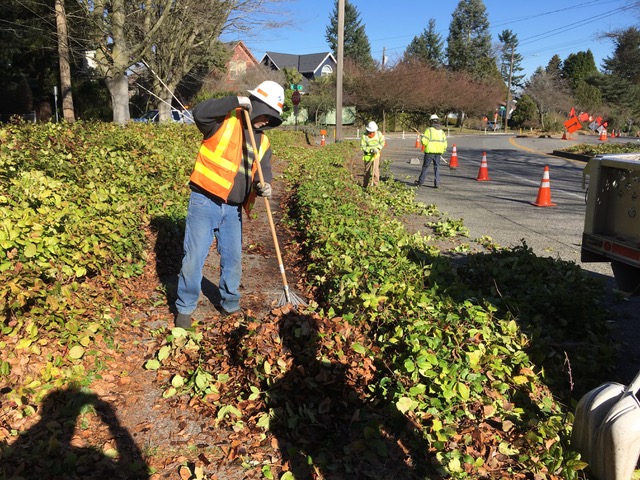
What’s the worst part of pedestrians’ problem? Worsening traffic fatalities and injuries for pedestrians, certainly. But there is also the poor condition of sidewalks and the big areas of the city with no sidewalks. And the prospects of facing bike riders and skateboarders with their new e-assist technology traveling much faster than everyone else on the sidewalks.
With so much dismal news to report, were there any bright spots in 2017? Other than the arguably ironic humor in the City Council's approval of a new Pedestrian Master Plan with a vision statement of making Seattle “the most walkable and accessible city in the nation.”
The one bright spot might be that SDOT, as the agency that designs and regulates what broadly is called 'the streetscape.' It’s new manual, branded Seattle Streets Illustrated, is for planners, developers, citizens and SDOT’s engineers themselves, and educates on what the entire streetscape is supposed to be. According to Streets Illustrated, the system as a whole must be “efficient, safe and attractive.”
The manual’s stated purpose “is to balance the access and mobility needs of everyone who uses and travels in the right-of-way: people walking, biking, driving, riding transit or moving goods.” It will tell you, for example, how transit stops are supposed to look and function. Or how to vision every imaginable bicycle facility.
The manual can be a tool for pedestrian activism. First, it stipulates what a proper sidewalk is supposed to be for safety, accessibility and the intended functions of mobility. Second, it makes crystal clear that the centerpiece of every sidewalk is called the Pedestrian Clear Zone, defined as “specifically reserved for pedestrian travel.”
Safety for walkers lies in enforcement of safe driving laws, better signals and re-painting the ghost crosswalks. Safety for walkers means fixing broken defects and speeding construction of the most badly needed missing sidewalks. Safety for everyone means tamping down rather than condoning incompatible intrusion of fast two-wheeled users, electric motor boosted or otherwise, who shouldn’t be weaving past walkers on congested sidewalks.
Pedestrians can regain their entitlement to safe, comfortable and secure walking in their own city if they will take up the fight against chronic underfunding, long-standing bureaucratic inattention, and intrusive encroachment of bikes and other users on the pedestrian environment. It is, after all, the sidewalks that should be the welcoming province of the pedestrian realm.
To see the first part of the series, go here.

